A Behavioural Explanation of Finance Puzzles
VerifiedAdded on 2023/03/31
|13
|2742
|170
AI Summary
This paper overviews the conduct finance clarification of two puzzles of finance: stock cost under-and overreactions and excessive trading and the gender astound. After a presentation of prospect hypothesis and a depiction of heuristics and predispositions in the judgment of data, the paper applies social bits of knowledge to clarify the puzzles.
Contribute Materials
Your contribution can guide someone’s learning journey. Share your
documents today.
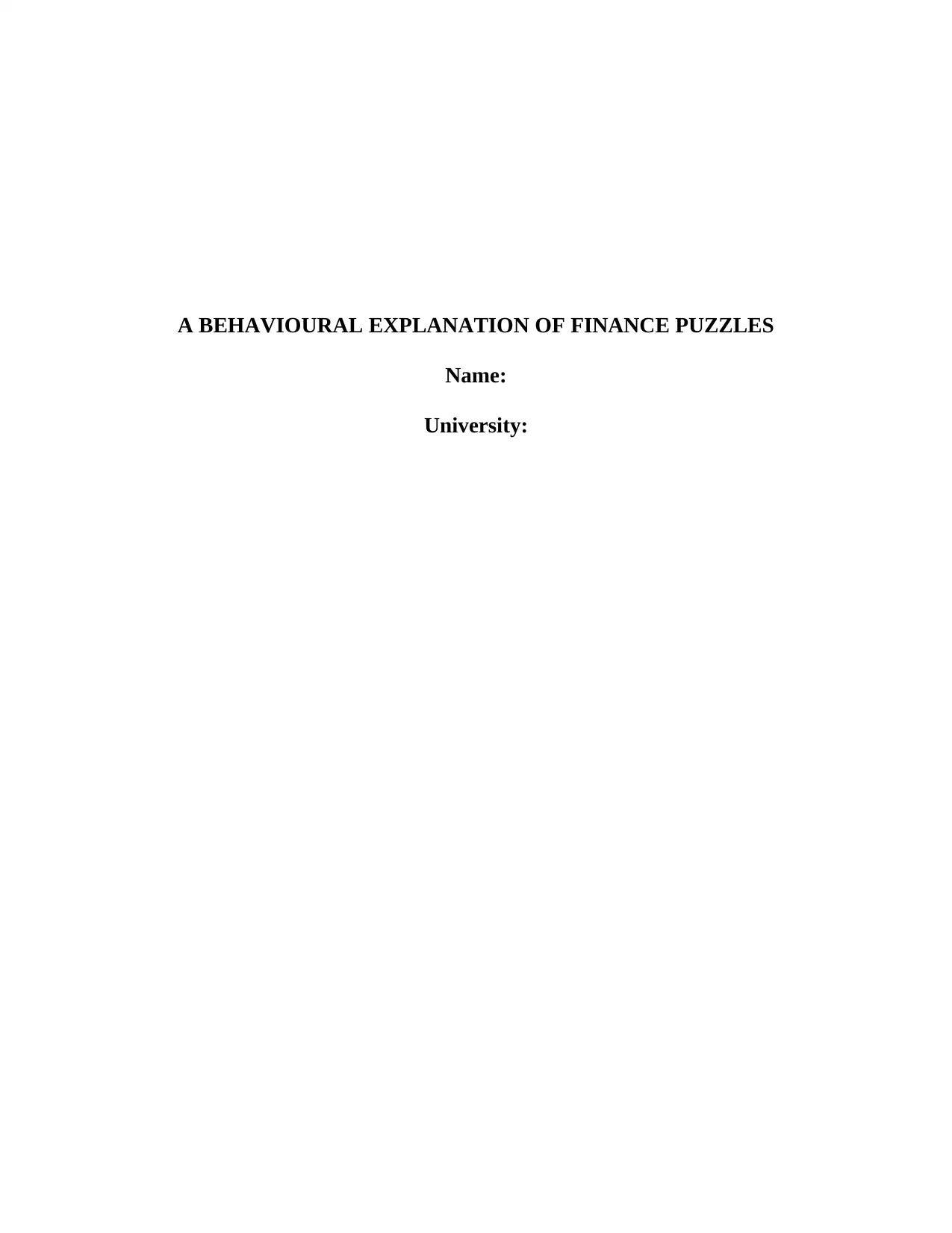
A BEHAVIOURAL EXPLANATION OF FINANCE PUZZLES
Name:
University:
Name:
University:
Secure Best Marks with AI Grader
Need help grading? Try our AI Grader for instant feedback on your assignments.
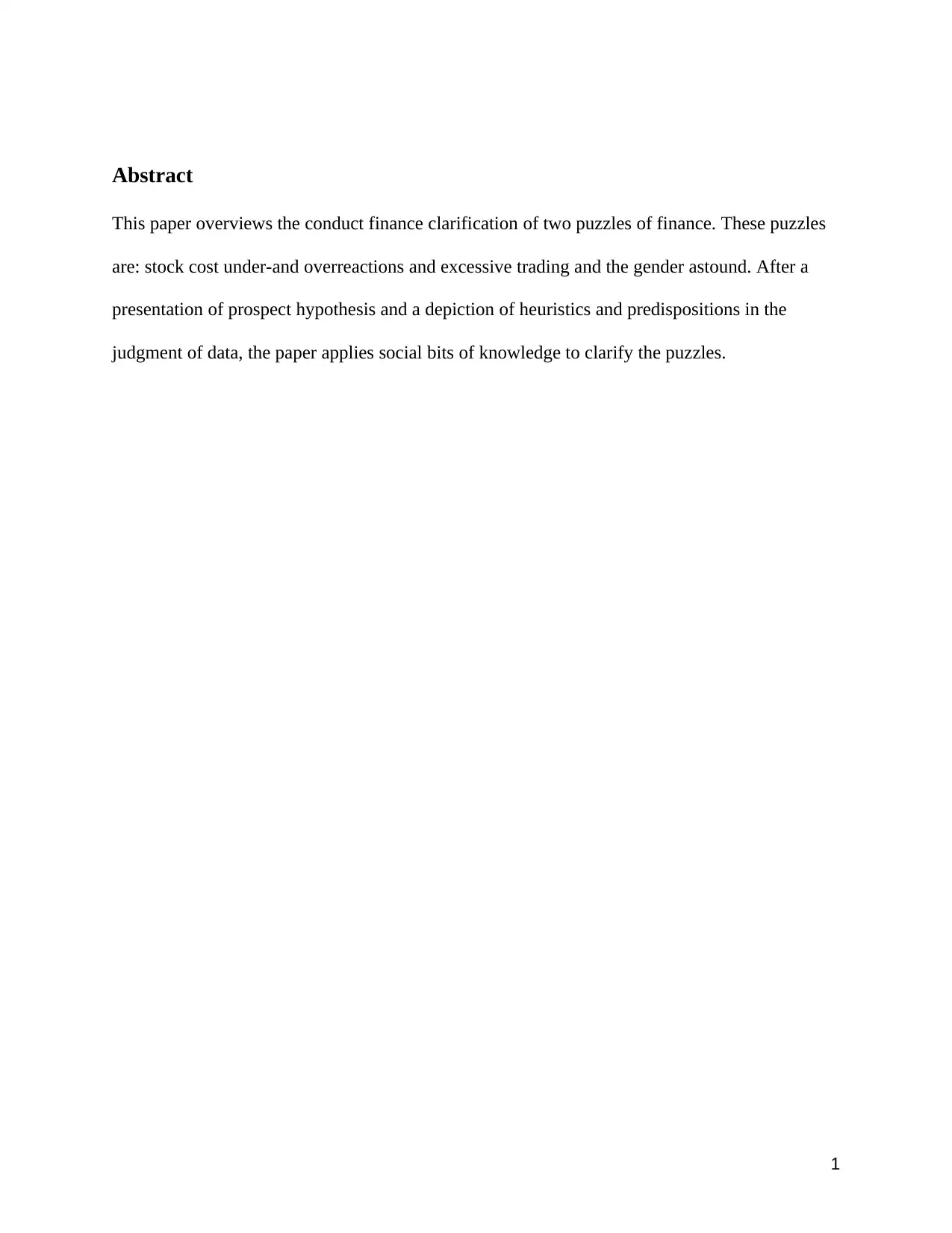
Abstract
This paper overviews the conduct finance clarification of two puzzles of finance. These puzzles
are: stock cost under-and overreactions and excessive trading and the gender astound. After a
presentation of prospect hypothesis and a depiction of heuristics and predispositions in the
judgment of data, the paper applies social bits of knowledge to clarify the puzzles.
1
This paper overviews the conduct finance clarification of two puzzles of finance. These puzzles
are: stock cost under-and overreactions and excessive trading and the gender astound. After a
presentation of prospect hypothesis and a depiction of heuristics and predispositions in the
judgment of data, the paper applies social bits of knowledge to clarify the puzzles.
1
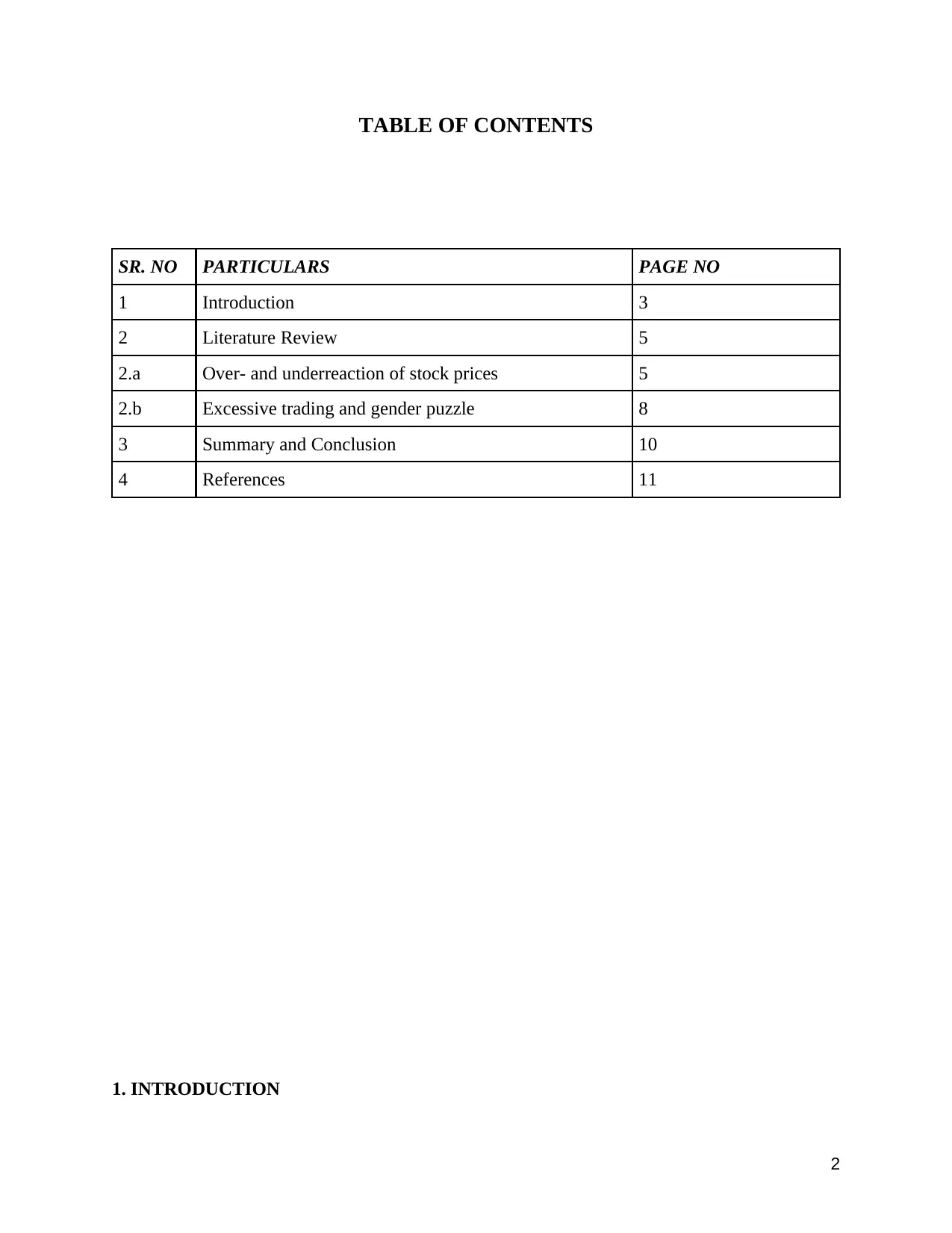
TABLE OF CONTENTS
SR. NO PARTICULARS PAGE NO
1 Introduction 3
2 Literature Review 5
2.a Over- and underreaction of stock prices 5
2.b Excessive trading and gender puzzle 8
3 Summary and Conclusion 10
4 References 11
1. INTRODUCTION
2
SR. NO PARTICULARS PAGE NO
1 Introduction 3
2 Literature Review 5
2.a Over- and underreaction of stock prices 5
2.b Excessive trading and gender puzzle 8
3 Summary and Conclusion 10
4 References 11
1. INTRODUCTION
2
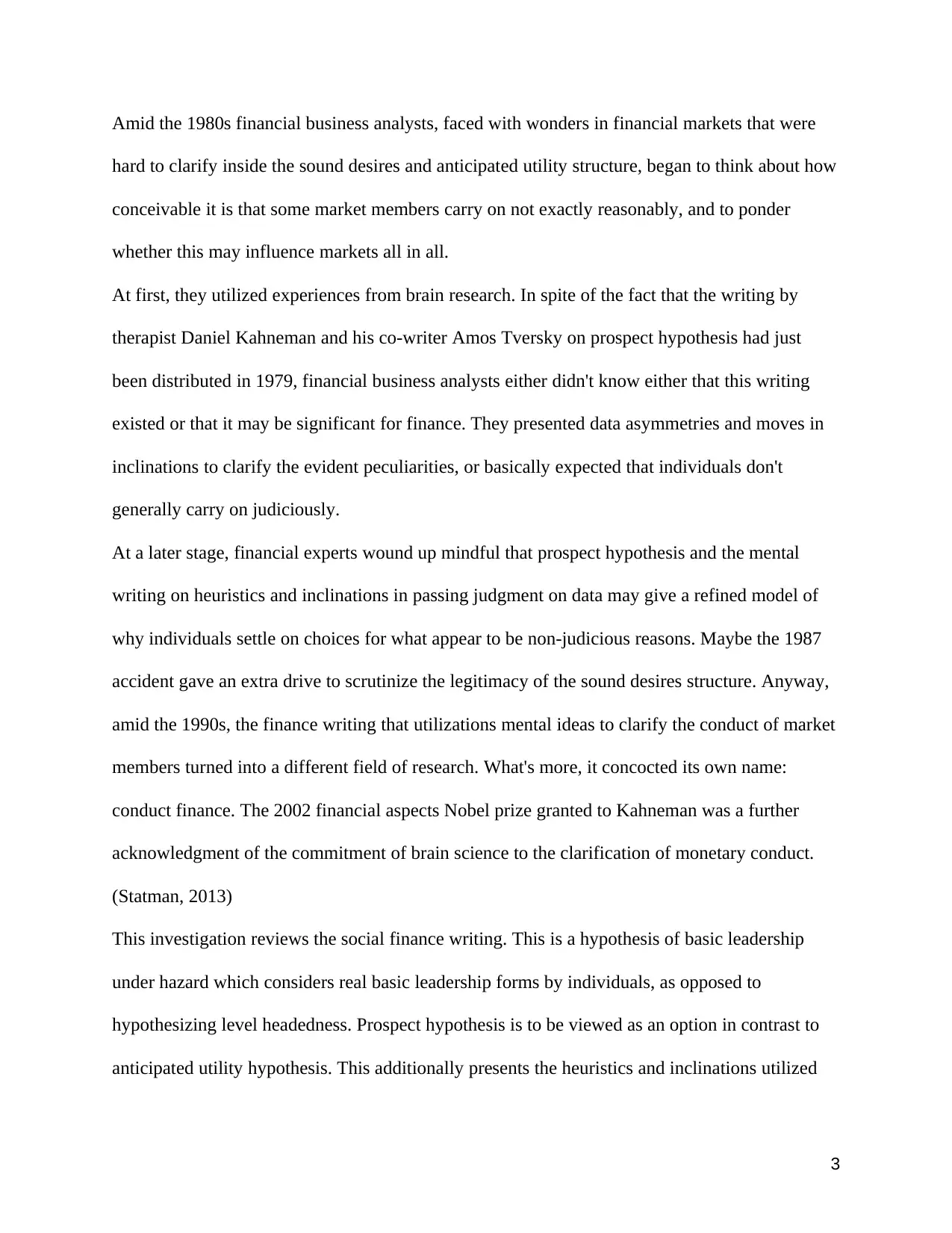
Amid the 1980s financial business analysts, faced with wonders in financial markets that were
hard to clarify inside the sound desires and anticipated utility structure, began to think about how
conceivable it is that some market members carry on not exactly reasonably, and to ponder
whether this may influence markets all in all.
At first, they utilized experiences from brain research. In spite of the fact that the writing by
therapist Daniel Kahneman and his co-writer Amos Tversky on prospect hypothesis had just
been distributed in 1979, financial business analysts either didn't know either that this writing
existed or that it may be significant for finance. They presented data asymmetries and moves in
inclinations to clarify the evident peculiarities, or basically expected that individuals don't
generally carry on judiciously.
At a later stage, financial experts wound up mindful that prospect hypothesis and the mental
writing on heuristics and inclinations in passing judgment on data may give a refined model of
why individuals settle on choices for what appear to be non-judicious reasons. Maybe the 1987
accident gave an extra drive to scrutinize the legitimacy of the sound desires structure. Anyway,
amid the 1990s, the finance writing that utilizations mental ideas to clarify the conduct of market
members turned into a different field of research. What's more, it concocted its own name:
conduct finance. The 2002 financial aspects Nobel prize granted to Kahneman was a further
acknowledgment of the commitment of brain science to the clarification of monetary conduct.
(Statman, 2013)
This investigation reviews the social finance writing. This is a hypothesis of basic leadership
under hazard which considers real basic leadership forms by individuals, as opposed to
hypothesizing level headedness. Prospect hypothesis is to be viewed as an option in contrast to
anticipated utility hypothesis. This additionally presents the heuristics and inclinations utilized
3
hard to clarify inside the sound desires and anticipated utility structure, began to think about how
conceivable it is that some market members carry on not exactly reasonably, and to ponder
whether this may influence markets all in all.
At first, they utilized experiences from brain research. In spite of the fact that the writing by
therapist Daniel Kahneman and his co-writer Amos Tversky on prospect hypothesis had just
been distributed in 1979, financial business analysts either didn't know either that this writing
existed or that it may be significant for finance. They presented data asymmetries and moves in
inclinations to clarify the evident peculiarities, or basically expected that individuals don't
generally carry on judiciously.
At a later stage, financial experts wound up mindful that prospect hypothesis and the mental
writing on heuristics and inclinations in passing judgment on data may give a refined model of
why individuals settle on choices for what appear to be non-judicious reasons. Maybe the 1987
accident gave an extra drive to scrutinize the legitimacy of the sound desires structure. Anyway,
amid the 1990s, the finance writing that utilizations mental ideas to clarify the conduct of market
members turned into a different field of research. What's more, it concocted its own name:
conduct finance. The 2002 financial aspects Nobel prize granted to Kahneman was a further
acknowledgment of the commitment of brain science to the clarification of monetary conduct.
(Statman, 2013)
This investigation reviews the social finance writing. This is a hypothesis of basic leadership
under hazard which considers real basic leadership forms by individuals, as opposed to
hypothesizing level headedness. Prospect hypothesis is to be viewed as an option in contrast to
anticipated utility hypothesis. This additionally presents the heuristics and inclinations utilized
3
Secure Best Marks with AI Grader
Need help grading? Try our AI Grader for instant feedback on your assignments.
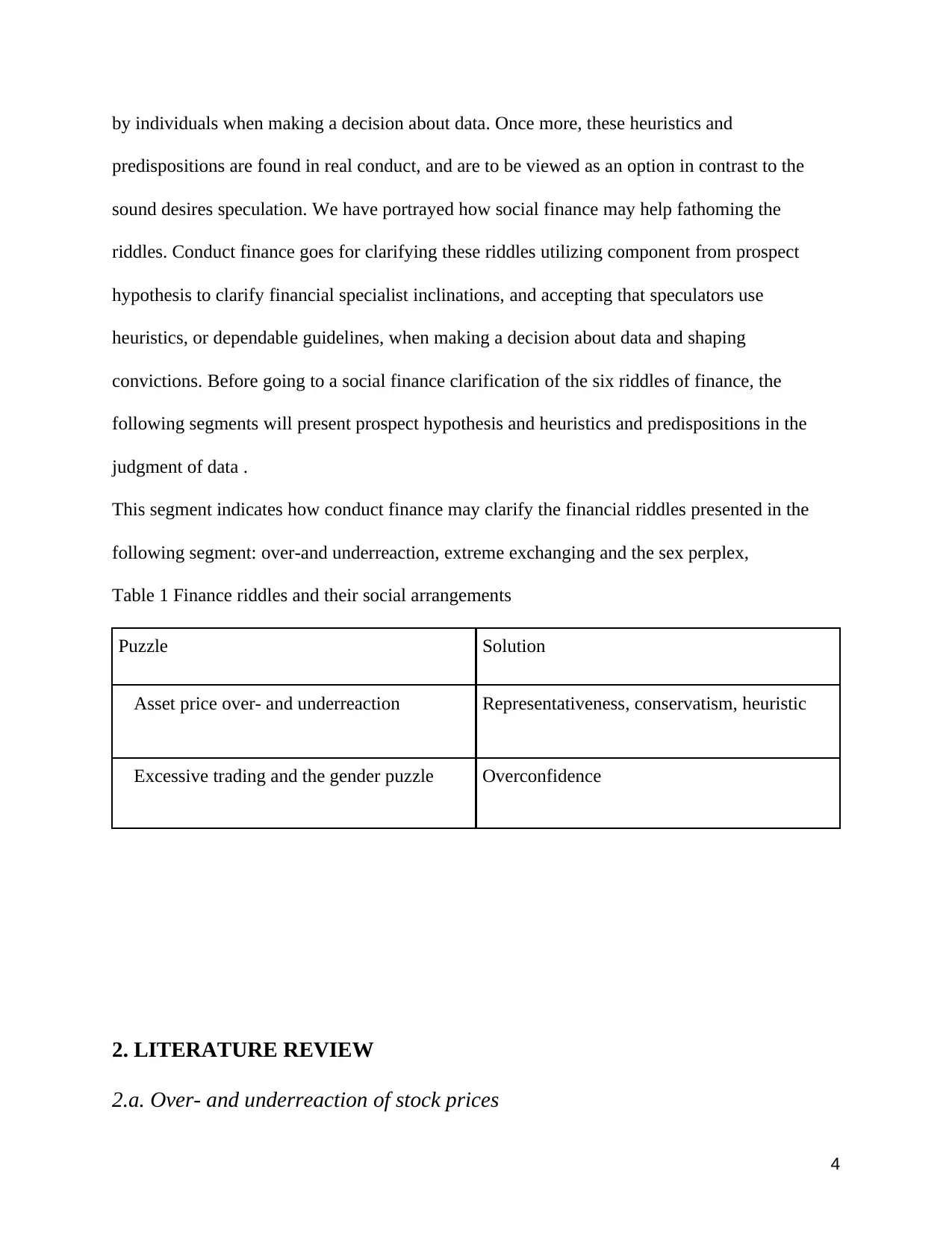
by individuals when making a decision about data. Once more, these heuristics and
predispositions are found in real conduct, and are to be viewed as an option in contrast to the
sound desires speculation. We have portrayed how social finance may help fathoming the
riddles. Conduct finance goes for clarifying these riddles utilizing component from prospect
hypothesis to clarify financial specialist inclinations, and accepting that speculators use
heuristics, or dependable guidelines, when making a decision about data and shaping
convictions. Before going to a social finance clarification of the six riddles of finance, the
following segments will present prospect hypothesis and heuristics and predispositions in the
judgment of data .
This segment indicates how conduct finance may clarify the financial riddles presented in the
following segment: over-and underreaction, extreme exchanging and the sex perplex,
Table 1 Finance riddles and their social arrangements
Puzzle Solution
Asset price over- and underreaction Representativeness, conservatism, heuristic
Excessive trading and the gender puzzle Overconfidence
2. LITERATURE REVIEW
2.a. Over- and underreaction of stock prices
4
predispositions are found in real conduct, and are to be viewed as an option in contrast to the
sound desires speculation. We have portrayed how social finance may help fathoming the
riddles. Conduct finance goes for clarifying these riddles utilizing component from prospect
hypothesis to clarify financial specialist inclinations, and accepting that speculators use
heuristics, or dependable guidelines, when making a decision about data and shaping
convictions. Before going to a social finance clarification of the six riddles of finance, the
following segments will present prospect hypothesis and heuristics and predispositions in the
judgment of data .
This segment indicates how conduct finance may clarify the financial riddles presented in the
following segment: over-and underreaction, extreme exchanging and the sex perplex,
Table 1 Finance riddles and their social arrangements
Puzzle Solution
Asset price over- and underreaction Representativeness, conservatism, heuristic
Excessive trading and the gender puzzle Overconfidence
2. LITERATURE REVIEW
2.a. Over- and underreaction of stock prices
4

An underreaction of stock costs happens if the securities trade responds to news not just in the
period following the news is discharged, yet what's more in ensuing periods. Ejection happens in
the contrary case: the news is quickly trailed by a stock esteem response, which in the resulting
time frames is somewhat remunerated by in any occasion one alters in the contrary course.
Diverse direct finance models endeavor to explain these instances of under-and overreactions.
(Stylist and Odean, 2014) use the thoughts of conservatism and the representativeness heuristic;
(Daniel, Hirshleifer and Subrahmanyam, 2018) center around uneven self-attribution and
carelessness.
(Barberis, Shleifer and Vishny, 2018) depict underreaction as a circumstance in which the arrival
in the period following the formation of motivating news (and after verifiably the essential
response of stock costs) is everything viewed as higher than it would have been had the news
been horrendous. In a profitable market, the news would be completely masterminded in the
period following quickly upon the news discharge. Starting now and into the foreseeable future,
in following periods, the improvement of stock costs would act naturally administering of the
news discharged in the principal time distribution. In the event that, after an inspiring news
sureness, costs keep ascending, there likely been an underreaction in the period quickly
following the news. No ifs, ands or buts, if the response had been satisfactory, the rising would
have been perceived straightaway. An ejection happens if the cost responds too unequivocally.
Everything considered, the stock esteem increment (rot) will be trailed by decreases
(increments).
Barberis, Shleifer and Vishny address the instance of under-and over compensations by
cementing conservatism and the representativeness heuristic. They build up a model including
one inspector and one resource. All bit of leeway is paid out as advantage. The congruity cost of
5
period following the news is discharged, yet what's more in ensuing periods. Ejection happens in
the contrary case: the news is quickly trailed by a stock esteem response, which in the resulting
time frames is somewhat remunerated by in any occasion one alters in the contrary course.
Diverse direct finance models endeavor to explain these instances of under-and overreactions.
(Stylist and Odean, 2014) use the thoughts of conservatism and the representativeness heuristic;
(Daniel, Hirshleifer and Subrahmanyam, 2018) center around uneven self-attribution and
carelessness.
(Barberis, Shleifer and Vishny, 2018) depict underreaction as a circumstance in which the arrival
in the period following the formation of motivating news (and after verifiably the essential
response of stock costs) is everything viewed as higher than it would have been had the news
been horrendous. In a profitable market, the news would be completely masterminded in the
period following quickly upon the news discharge. Starting now and into the foreseeable future,
in following periods, the improvement of stock costs would act naturally administering of the
news discharged in the principal time distribution. In the event that, after an inspiring news
sureness, costs keep ascending, there likely been an underreaction in the period quickly
following the news. No ifs, ands or buts, if the response had been satisfactory, the rising would
have been perceived straightaway. An ejection happens if the cost responds too unequivocally.
Everything considered, the stock esteem increment (rot) will be trailed by decreases
(increments).
Barberis, Shleifer and Vishny address the instance of under-and over compensations by
cementing conservatism and the representativeness heuristic. They build up a model including
one inspector and one resource. All bit of leeway is paid out as advantage. The congruity cost of
5

the favored position approaches the net present estimation of predicted returns. Stock costs rely
on news since fiscal specialists use news to animate their suppositions concerning future pay.
Regardless, conservatism makes news be insufficiently reflected in costs for the present. The
standard cash related ace changes more well ordered than would be flawless and costs put aside
more exertion to achieve the new equality than would be the situation with sensible Bayesian
learning. This clarifies the temporary underreaction. In the more drawn out term, the
representativeness heuristic begins the budgetary master to join an unreasonable proportion of
basic worth to a news reality on the off chance that it is somewhat of a development of a self-
self-assured course of action of comparative messages wherein the scholar wrongly watches a
pattern.6 The cash related professional trusts that one of two calendars applies, for example
either points of interest are 'mean-returning', with a positive trance being trailed by a negative
one, or they are portrayed by a precedent. In the event that the scholar has seen a development of
good pay stuns, his conviction that preferences look for after a precedent makes. Then again, in
the event that he has seen a development of changes structure positive to negative pay
incapacitates and the an alternate way, change to the conviction that advantage are mean-
returning. These updates of sentiments are intended to address the instruments of the
representativeness heuristic and conservatism. Reflecting advantage with a self-confident walk
model, Barberis, Shleifer and Vishny show that, subordinate upon the attributes picked for the
parameters, these real suppositions may pass on an instance of underreactions, an instance of
overcompensations or an instance of underreactions substituted by eruptions.
Daniel, Hirshleifer and Subrahmanyam (2018) develop a model of budgetary expert direct that
surveys carelessness and uneven self-attribution. They model these psychological instruments by
tolerating that monetary authorities will when all is said in done overestimate their proportion of
6
on news since fiscal specialists use news to animate their suppositions concerning future pay.
Regardless, conservatism makes news be insufficiently reflected in costs for the present. The
standard cash related ace changes more well ordered than would be flawless and costs put aside
more exertion to achieve the new equality than would be the situation with sensible Bayesian
learning. This clarifies the temporary underreaction. In the more drawn out term, the
representativeness heuristic begins the budgetary master to join an unreasonable proportion of
basic worth to a news reality on the off chance that it is somewhat of a development of a self-
self-assured course of action of comparative messages wherein the scholar wrongly watches a
pattern.6 The cash related professional trusts that one of two calendars applies, for example
either points of interest are 'mean-returning', with a positive trance being trailed by a negative
one, or they are portrayed by a precedent. In the event that the scholar has seen a development of
good pay stuns, his conviction that preferences look for after a precedent makes. Then again, in
the event that he has seen a development of changes structure positive to negative pay
incapacitates and the an alternate way, change to the conviction that advantage are mean-
returning. These updates of sentiments are intended to address the instruments of the
representativeness heuristic and conservatism. Reflecting advantage with a self-confident walk
model, Barberis, Shleifer and Vishny show that, subordinate upon the attributes picked for the
parameters, these real suppositions may pass on an instance of underreactions, an instance of
overcompensations or an instance of underreactions substituted by eruptions.
Daniel, Hirshleifer and Subrahmanyam (2018) develop a model of budgetary expert direct that
surveys carelessness and uneven self-attribution. They model these psychological instruments by
tolerating that monetary authorities will when all is said in done overestimate their proportion of
6
Paraphrase This Document
Need a fresh take? Get an instant paraphrase of this document with our AI Paraphraser
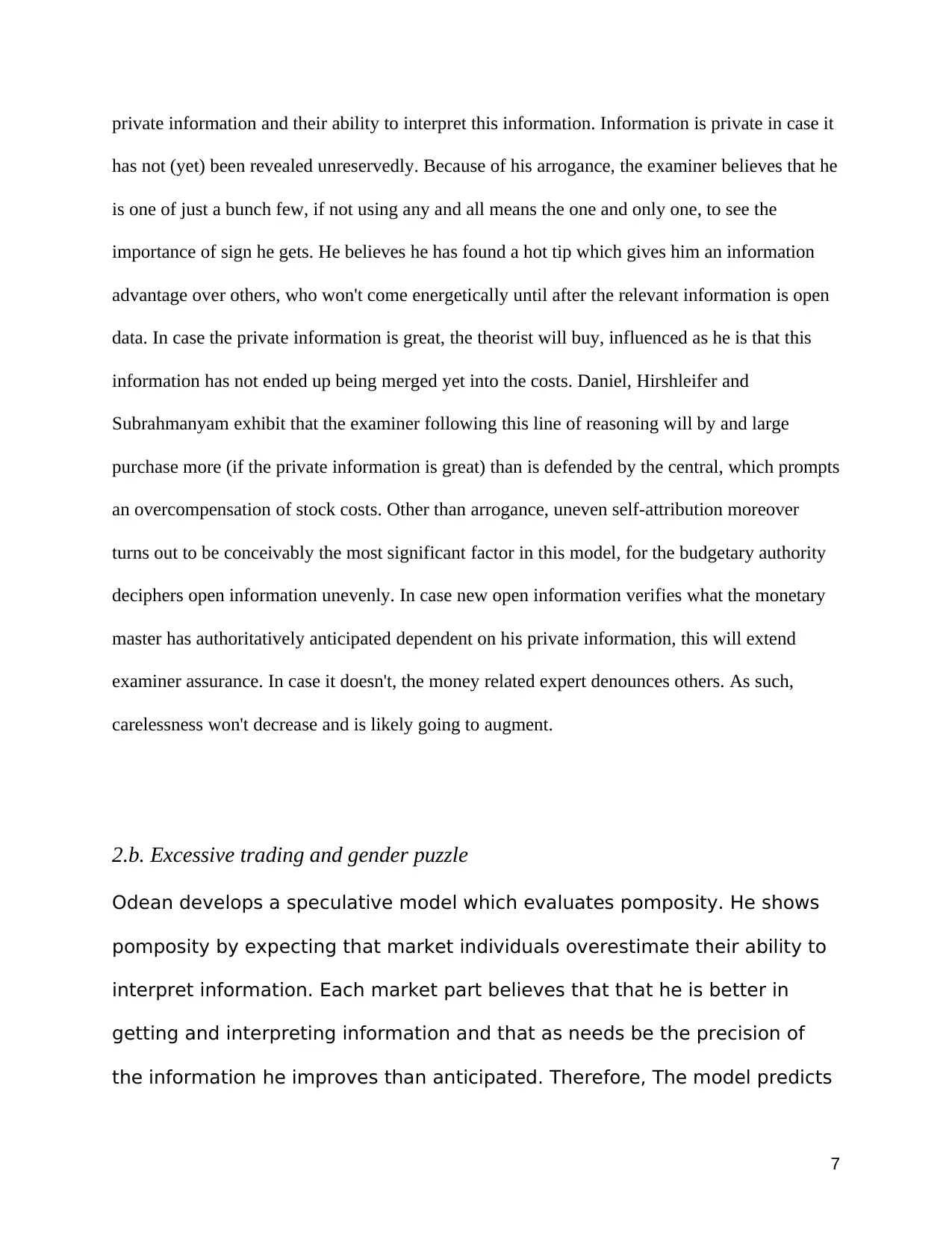
private information and their ability to interpret this information. Information is private in case it
has not (yet) been revealed unreservedly. Because of his arrogance, the examiner believes that he
is one of just a bunch few, if not using any and all means the one and only one, to see the
importance of sign he gets. He believes he has found a hot tip which gives him an information
advantage over others, who won't come energetically until after the relevant information is open
data. In case the private information is great, the theorist will buy, influenced as he is that this
information has not ended up being merged yet into the costs. Daniel, Hirshleifer and
Subrahmanyam exhibit that the examiner following this line of reasoning will by and large
purchase more (if the private information is great) than is defended by the central, which prompts
an overcompensation of stock costs. Other than arrogance, uneven self-attribution moreover
turns out to be conceivably the most significant factor in this model, for the budgetary authority
deciphers open information unevenly. In case new open information verifies what the monetary
master has authoritatively anticipated dependent on his private information, this will extend
examiner assurance. In case it doesn't, the money related expert denounces others. As such,
carelessness won't decrease and is likely going to augment.
2.b. Excessive trading and gender puzzle
Odean develops a speculative model which evaluates pomposity. He shows
pomposity by expecting that market individuals overestimate their ability to
interpret information. Each market part believes that that he is better in
getting and interpreting information and that as needs be the precision of
the information he improves than anticipated. Therefore, The model predicts
7
has not (yet) been revealed unreservedly. Because of his arrogance, the examiner believes that he
is one of just a bunch few, if not using any and all means the one and only one, to see the
importance of sign he gets. He believes he has found a hot tip which gives him an information
advantage over others, who won't come energetically until after the relevant information is open
data. In case the private information is great, the theorist will buy, influenced as he is that this
information has not ended up being merged yet into the costs. Daniel, Hirshleifer and
Subrahmanyam exhibit that the examiner following this line of reasoning will by and large
purchase more (if the private information is great) than is defended by the central, which prompts
an overcompensation of stock costs. Other than arrogance, uneven self-attribution moreover
turns out to be conceivably the most significant factor in this model, for the budgetary authority
deciphers open information unevenly. In case new open information verifies what the monetary
master has authoritatively anticipated dependent on his private information, this will extend
examiner assurance. In case it doesn't, the money related expert denounces others. As such,
carelessness won't decrease and is likely going to augment.
2.b. Excessive trading and gender puzzle
Odean develops a speculative model which evaluates pomposity. He shows
pomposity by expecting that market individuals overestimate their ability to
interpret information. Each market part believes that that he is better in
getting and interpreting information and that as needs be the precision of
the information he improves than anticipated. Therefore, The model predicts
7
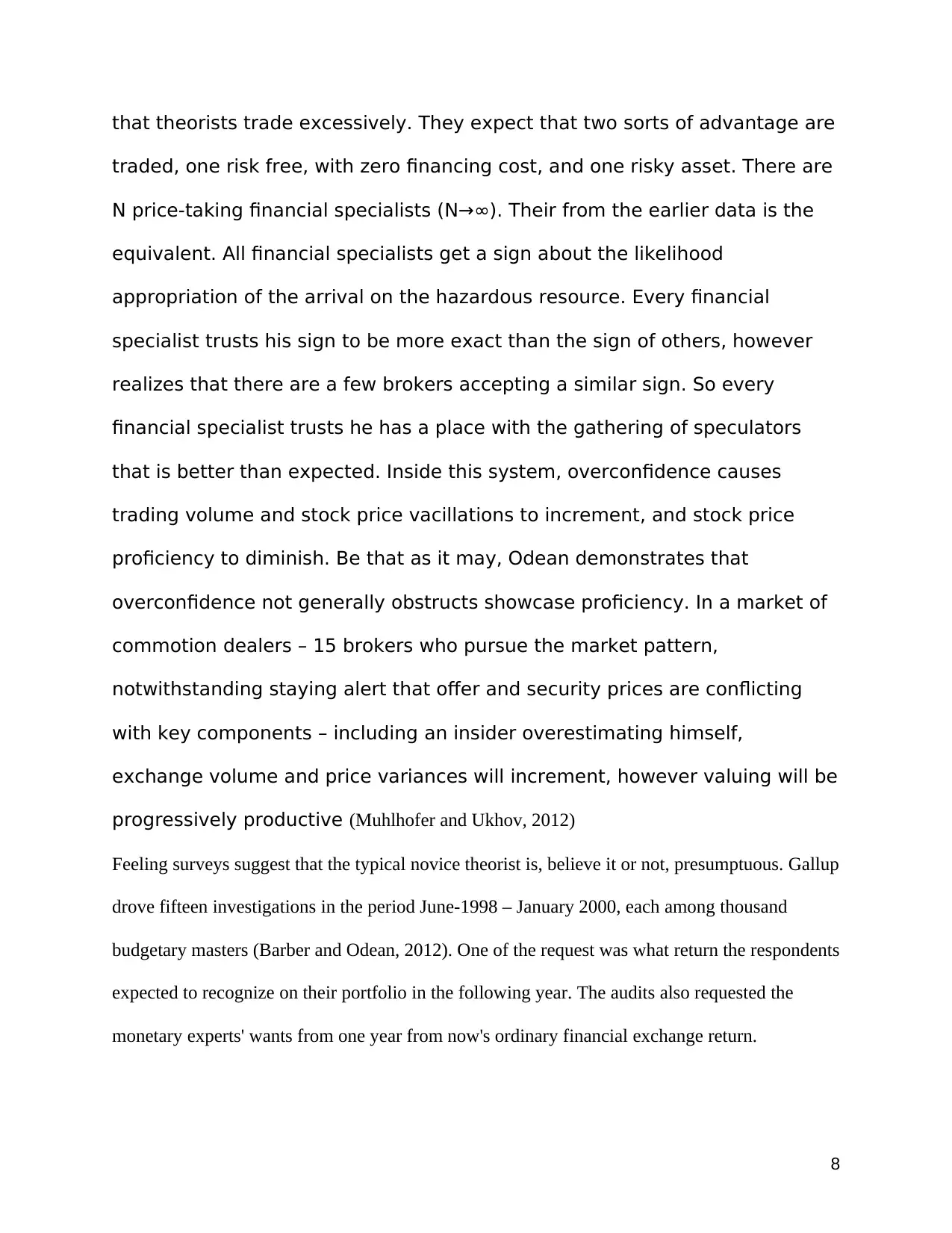
that theorists trade excessively. They expect that two sorts of advantage are
traded, one risk free, with zero financing cost, and one risky asset. There are
N price-taking financial specialists (N→∞). Their from the earlier data is the
equivalent. All financial specialists get a sign about the likelihood
appropriation of the arrival on the hazardous resource. Every financial
specialist trusts his sign to be more exact than the sign of others, however
realizes that there are a few brokers accepting a similar sign. So every
financial specialist trusts he has a place with the gathering of speculators
that is better than expected. Inside this system, overconfidence causes
trading volume and stock price vacillations to increment, and stock price
proficiency to diminish. Be that as it may, Odean demonstrates that
overconfidence not generally obstructs showcase proficiency. In a market of
commotion dealers – 15 brokers who pursue the market pattern,
notwithstanding staying alert that offer and security prices are conflicting
with key components – including an insider overestimating himself,
exchange volume and price variances will increment, however valuing will be
progressively productive (Muhlhofer and Ukhov, 2012)
Feeling surveys suggest that the typical novice theorist is, believe it or not, presumptuous. Gallup
drove fifteen investigations in the period June-1998 – January 2000, each among thousand
budgetary masters (Barber and Odean, 2012). One of the request was what return the respondents
expected to recognize on their portfolio in the following year. The audits also requested the
monetary experts' wants from one year from now's ordinary financial exchange return.
8
traded, one risk free, with zero financing cost, and one risky asset. There are
N price-taking financial specialists (N→∞). Their from the earlier data is the
equivalent. All financial specialists get a sign about the likelihood
appropriation of the arrival on the hazardous resource. Every financial
specialist trusts his sign to be more exact than the sign of others, however
realizes that there are a few brokers accepting a similar sign. So every
financial specialist trusts he has a place with the gathering of speculators
that is better than expected. Inside this system, overconfidence causes
trading volume and stock price vacillations to increment, and stock price
proficiency to diminish. Be that as it may, Odean demonstrates that
overconfidence not generally obstructs showcase proficiency. In a market of
commotion dealers – 15 brokers who pursue the market pattern,
notwithstanding staying alert that offer and security prices are conflicting
with key components – including an insider overestimating himself,
exchange volume and price variances will increment, however valuing will be
progressively productive (Muhlhofer and Ukhov, 2012)
Feeling surveys suggest that the typical novice theorist is, believe it or not, presumptuous. Gallup
drove fifteen investigations in the period June-1998 – January 2000, each among thousand
budgetary masters (Barber and Odean, 2012). One of the request was what return the respondents
expected to recognize on their portfolio in the following year. The audits also requested the
monetary experts' wants from one year from now's ordinary financial exchange return.
8
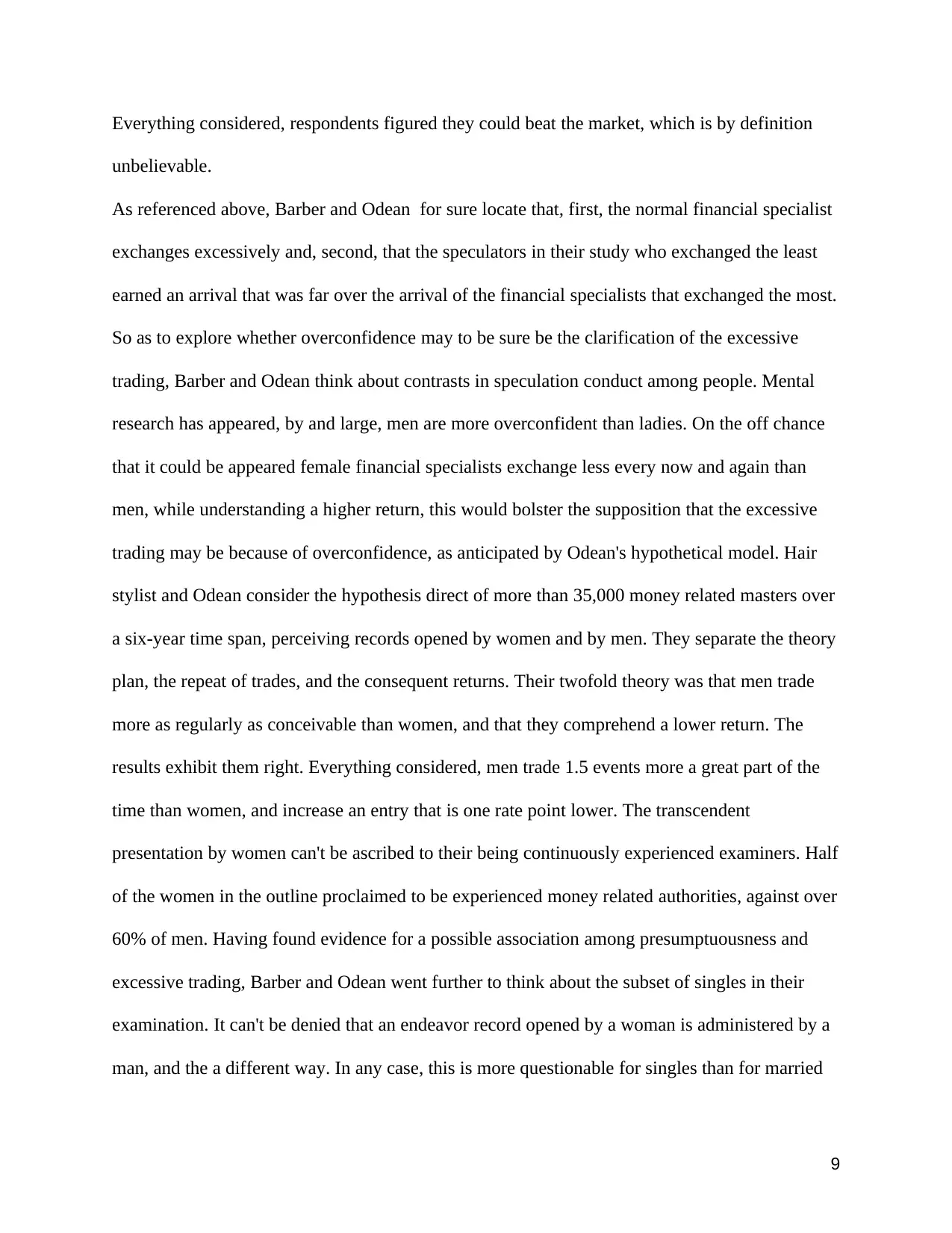
Everything considered, respondents figured they could beat the market, which is by definition
unbelievable.
As referenced above, Barber and Odean for sure locate that, first, the normal financial specialist
exchanges excessively and, second, that the speculators in their study who exchanged the least
earned an arrival that was far over the arrival of the financial specialists that exchanged the most.
So as to explore whether overconfidence may to be sure be the clarification of the excessive
trading, Barber and Odean think about contrasts in speculation conduct among people. Mental
research has appeared, by and large, men are more overconfident than ladies. On the off chance
that it could be appeared female financial specialists exchange less every now and again than
men, while understanding a higher return, this would bolster the supposition that the excessive
trading may be because of overconfidence, as anticipated by Odean's hypothetical model. Hair
stylist and Odean consider the hypothesis direct of more than 35,000 money related masters over
a six-year time span, perceiving records opened by women and by men. They separate the theory
plan, the repeat of trades, and the consequent returns. Their twofold theory was that men trade
more as regularly as conceivable than women, and that they comprehend a lower return. The
results exhibit them right. Everything considered, men trade 1.5 events more a great part of the
time than women, and increase an entry that is one rate point lower. The transcendent
presentation by women can't be ascribed to their being continuously experienced examiners. Half
of the women in the outline proclaimed to be experienced money related authorities, against over
60% of men. Having found evidence for a possible association among presumptuousness and
excessive trading, Barber and Odean went further to think about the subset of singles in their
examination. It can't be denied that an endeavor record opened by a woman is administered by a
man, and the a different way. In any case, this is more questionable for singles than for married
9
unbelievable.
As referenced above, Barber and Odean for sure locate that, first, the normal financial specialist
exchanges excessively and, second, that the speculators in their study who exchanged the least
earned an arrival that was far over the arrival of the financial specialists that exchanged the most.
So as to explore whether overconfidence may to be sure be the clarification of the excessive
trading, Barber and Odean think about contrasts in speculation conduct among people. Mental
research has appeared, by and large, men are more overconfident than ladies. On the off chance
that it could be appeared female financial specialists exchange less every now and again than
men, while understanding a higher return, this would bolster the supposition that the excessive
trading may be because of overconfidence, as anticipated by Odean's hypothetical model. Hair
stylist and Odean consider the hypothesis direct of more than 35,000 money related masters over
a six-year time span, perceiving records opened by women and by men. They separate the theory
plan, the repeat of trades, and the consequent returns. Their twofold theory was that men trade
more as regularly as conceivable than women, and that they comprehend a lower return. The
results exhibit them right. Everything considered, men trade 1.5 events more a great part of the
time than women, and increase an entry that is one rate point lower. The transcendent
presentation by women can't be ascribed to their being continuously experienced examiners. Half
of the women in the outline proclaimed to be experienced money related authorities, against over
60% of men. Having found evidence for a possible association among presumptuousness and
excessive trading, Barber and Odean went further to think about the subset of singles in their
examination. It can't be denied that an endeavor record opened by a woman is administered by a
man, and the a different way. In any case, this is more questionable for singles than for married
9
Secure Best Marks with AI Grader
Need help grading? Try our AI Grader for instant feedback on your assignments.
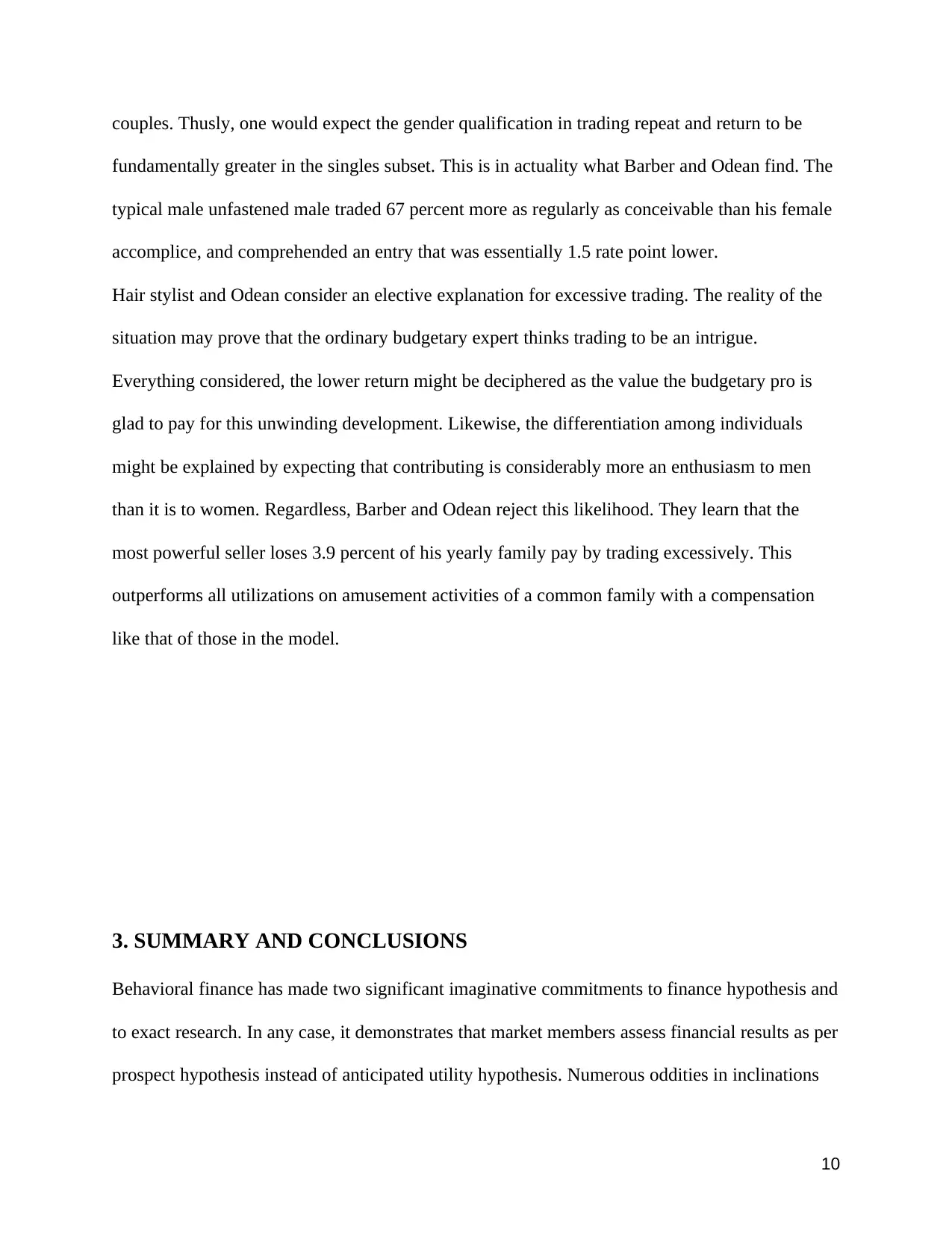
couples. Thusly, one would expect the gender qualification in trading repeat and return to be
fundamentally greater in the singles subset. This is in actuality what Barber and Odean find. The
typical male unfastened male traded 67 percent more as regularly as conceivable than his female
accomplice, and comprehended an entry that was essentially 1.5 rate point lower.
Hair stylist and Odean consider an elective explanation for excessive trading. The reality of the
situation may prove that the ordinary budgetary expert thinks trading to be an intrigue.
Everything considered, the lower return might be deciphered as the value the budgetary pro is
glad to pay for this unwinding development. Likewise, the differentiation among individuals
might be explained by expecting that contributing is considerably more an enthusiasm to men
than it is to women. Regardless, Barber and Odean reject this likelihood. They learn that the
most powerful seller loses 3.9 percent of his yearly family pay by trading excessively. This
outperforms all utilizations on amusement activities of a common family with a compensation
like that of those in the model.
3. SUMMARY AND CONCLUSIONS
Behavioral finance has made two significant imaginative commitments to finance hypothesis and
to exact research. In any case, it demonstrates that market members assess financial results as per
prospect hypothesis instead of anticipated utility hypothesis. Numerous oddities in inclinations
10
fundamentally greater in the singles subset. This is in actuality what Barber and Odean find. The
typical male unfastened male traded 67 percent more as regularly as conceivable than his female
accomplice, and comprehended an entry that was essentially 1.5 rate point lower.
Hair stylist and Odean consider an elective explanation for excessive trading. The reality of the
situation may prove that the ordinary budgetary expert thinks trading to be an intrigue.
Everything considered, the lower return might be deciphered as the value the budgetary pro is
glad to pay for this unwinding development. Likewise, the differentiation among individuals
might be explained by expecting that contributing is considerably more an enthusiasm to men
than it is to women. Regardless, Barber and Odean reject this likelihood. They learn that the
most powerful seller loses 3.9 percent of his yearly family pay by trading excessively. This
outperforms all utilizations on amusement activities of a common family with a compensation
like that of those in the model.
3. SUMMARY AND CONCLUSIONS
Behavioral finance has made two significant imaginative commitments to finance hypothesis and
to exact research. In any case, it demonstrates that market members assess financial results as per
prospect hypothesis instead of anticipated utility hypothesis. Numerous oddities in inclinations
10
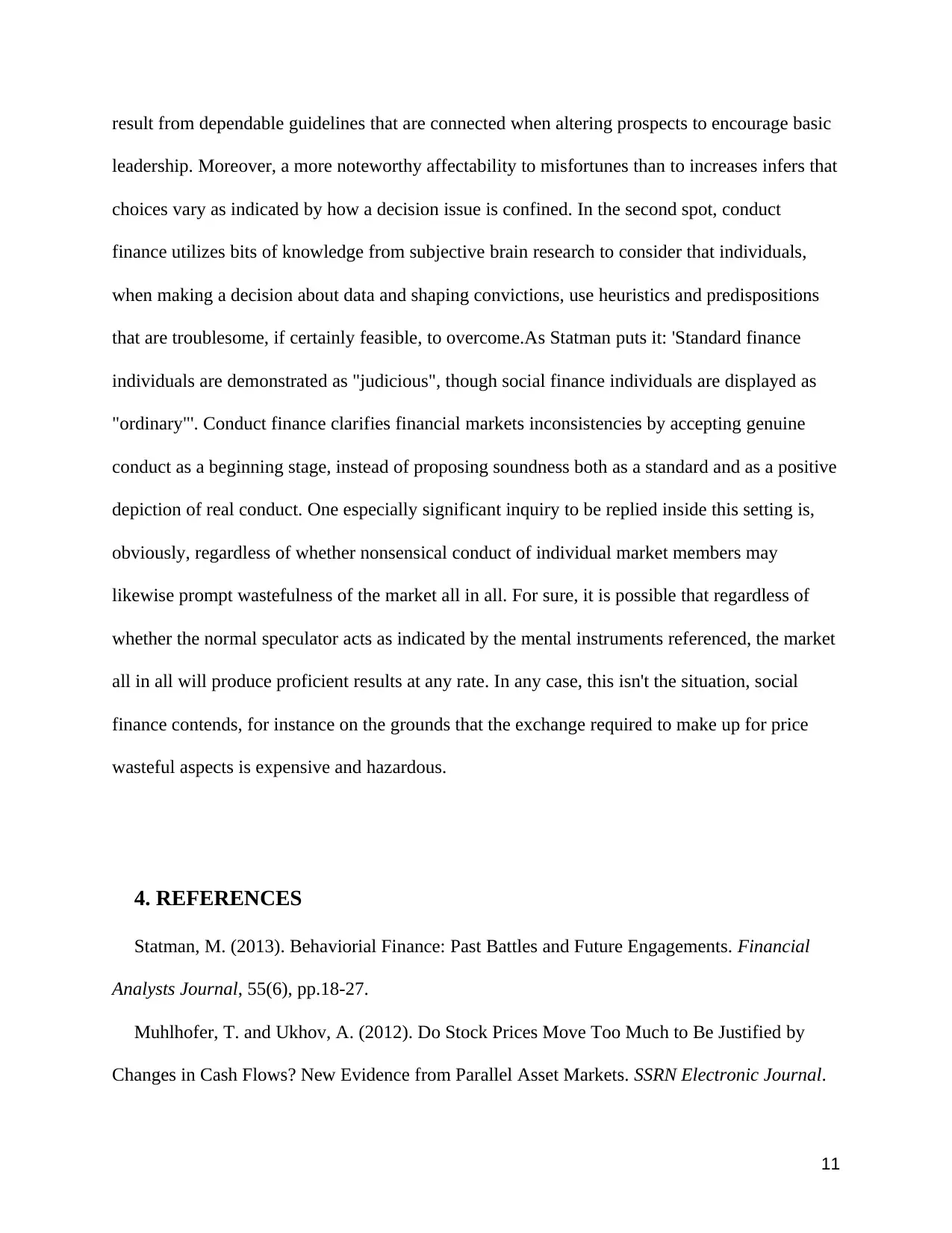
result from dependable guidelines that are connected when altering prospects to encourage basic
leadership. Moreover, a more noteworthy affectability to misfortunes than to increases infers that
choices vary as indicated by how a decision issue is confined. In the second spot, conduct
finance utilizes bits of knowledge from subjective brain research to consider that individuals,
when making a decision about data and shaping convictions, use heuristics and predispositions
that are troublesome, if certainly feasible, to overcome.As Statman puts it: 'Standard finance
individuals are demonstrated as "judicious", though social finance individuals are displayed as
"ordinary"'. Conduct finance clarifies financial markets inconsistencies by accepting genuine
conduct as a beginning stage, instead of proposing soundness both as a standard and as a positive
depiction of real conduct. One especially significant inquiry to be replied inside this setting is,
obviously, regardless of whether nonsensical conduct of individual market members may
likewise prompt wastefulness of the market all in all. For sure, it is possible that regardless of
whether the normal speculator acts as indicated by the mental instruments referenced, the market
all in all will produce proficient results at any rate. In any case, this isn't the situation, social
finance contends, for instance on the grounds that the exchange required to make up for price
wasteful aspects is expensive and hazardous.
4. REFERENCES
Statman, M. (2013). Behaviorial Finance: Past Battles and Future Engagements. Financial
Analysts Journal, 55(6), pp.18-27.
Muhlhofer, T. and Ukhov, A. (2012). Do Stock Prices Move Too Much to Be Justified by
Changes in Cash Flows? New Evidence from Parallel Asset Markets. SSRN Electronic Journal.
11
leadership. Moreover, a more noteworthy affectability to misfortunes than to increases infers that
choices vary as indicated by how a decision issue is confined. In the second spot, conduct
finance utilizes bits of knowledge from subjective brain research to consider that individuals,
when making a decision about data and shaping convictions, use heuristics and predispositions
that are troublesome, if certainly feasible, to overcome.As Statman puts it: 'Standard finance
individuals are demonstrated as "judicious", though social finance individuals are displayed as
"ordinary"'. Conduct finance clarifies financial markets inconsistencies by accepting genuine
conduct as a beginning stage, instead of proposing soundness both as a standard and as a positive
depiction of real conduct. One especially significant inquiry to be replied inside this setting is,
obviously, regardless of whether nonsensical conduct of individual market members may
likewise prompt wastefulness of the market all in all. For sure, it is possible that regardless of
whether the normal speculator acts as indicated by the mental instruments referenced, the market
all in all will produce proficient results at any rate. In any case, this isn't the situation, social
finance contends, for instance on the grounds that the exchange required to make up for price
wasteful aspects is expensive and hazardous.
4. REFERENCES
Statman, M. (2013). Behaviorial Finance: Past Battles and Future Engagements. Financial
Analysts Journal, 55(6), pp.18-27.
Muhlhofer, T. and Ukhov, A. (2012). Do Stock Prices Move Too Much to Be Justified by
Changes in Cash Flows? New Evidence from Parallel Asset Markets. SSRN Electronic Journal.
11
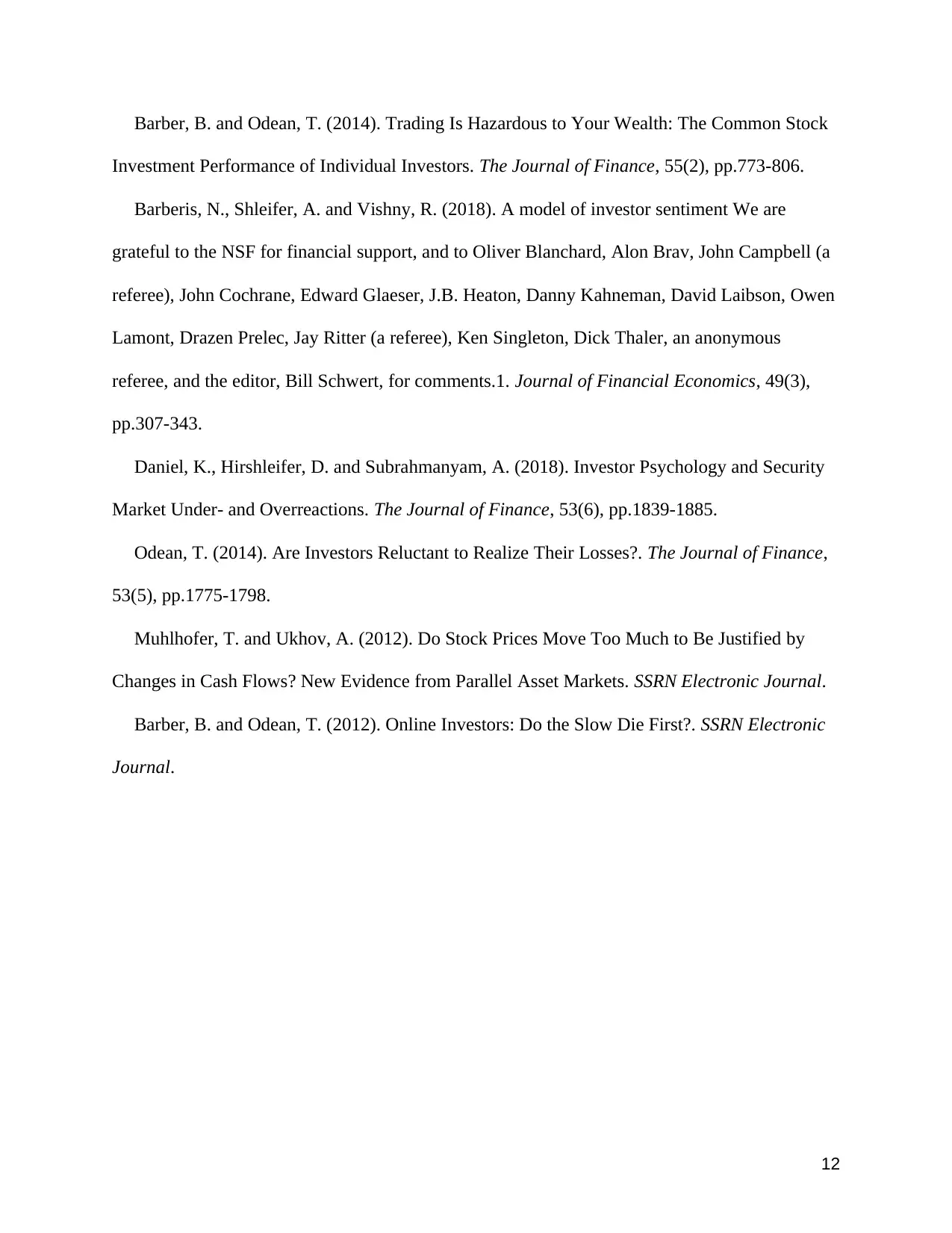
Barber, B. and Odean, T. (2014). Trading Is Hazardous to Your Wealth: The Common Stock
Investment Performance of Individual Investors. The Journal of Finance, 55(2), pp.773-806.
Barberis, N., Shleifer, A. and Vishny, R. (2018). A model of investor sentiment We are
grateful to the NSF for financial support, and to Oliver Blanchard, Alon Brav, John Campbell (a
referee), John Cochrane, Edward Glaeser, J.B. Heaton, Danny Kahneman, David Laibson, Owen
Lamont, Drazen Prelec, Jay Ritter (a referee), Ken Singleton, Dick Thaler, an anonymous
referee, and the editor, Bill Schwert, for comments.1. Journal of Financial Economics, 49(3),
pp.307-343.
Daniel, K., Hirshleifer, D. and Subrahmanyam, A. (2018). Investor Psychology and Security
Market Under- and Overreactions. The Journal of Finance, 53(6), pp.1839-1885.
Odean, T. (2014). Are Investors Reluctant to Realize Their Losses?. The Journal of Finance,
53(5), pp.1775-1798.
Muhlhofer, T. and Ukhov, A. (2012). Do Stock Prices Move Too Much to Be Justified by
Changes in Cash Flows? New Evidence from Parallel Asset Markets. SSRN Electronic Journal.
Barber, B. and Odean, T. (2012). Online Investors: Do the Slow Die First?. SSRN Electronic
Journal.
12
Investment Performance of Individual Investors. The Journal of Finance, 55(2), pp.773-806.
Barberis, N., Shleifer, A. and Vishny, R. (2018). A model of investor sentiment We are
grateful to the NSF for financial support, and to Oliver Blanchard, Alon Brav, John Campbell (a
referee), John Cochrane, Edward Glaeser, J.B. Heaton, Danny Kahneman, David Laibson, Owen
Lamont, Drazen Prelec, Jay Ritter (a referee), Ken Singleton, Dick Thaler, an anonymous
referee, and the editor, Bill Schwert, for comments.1. Journal of Financial Economics, 49(3),
pp.307-343.
Daniel, K., Hirshleifer, D. and Subrahmanyam, A. (2018). Investor Psychology and Security
Market Under- and Overreactions. The Journal of Finance, 53(6), pp.1839-1885.
Odean, T. (2014). Are Investors Reluctant to Realize Their Losses?. The Journal of Finance,
53(5), pp.1775-1798.
Muhlhofer, T. and Ukhov, A. (2012). Do Stock Prices Move Too Much to Be Justified by
Changes in Cash Flows? New Evidence from Parallel Asset Markets. SSRN Electronic Journal.
Barber, B. and Odean, T. (2012). Online Investors: Do the Slow Die First?. SSRN Electronic
Journal.
12
1 out of 13
Your All-in-One AI-Powered Toolkit for Academic Success.
+13062052269
info@desklib.com
Available 24*7 on WhatsApp / Email
![[object Object]](/_next/static/media/star-bottom.7253800d.svg)
Unlock your academic potential
© 2024 | Zucol Services PVT LTD | All rights reserved.